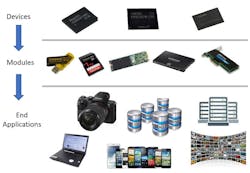NAND Flash Memory is on a Roll—Here’s Why! (.PDF Download)
Nonvolatile flash memory dates back over two decades. Invented in 1994, the first application for flash memory was replacing audio tape in a phone answering machine. Digital film and cassette tapes were other early casualties of the new technology.
The first devices used a NOR structure with random-access capability. NAND flash, although slower, offered lower cost per bit and has replaced NOR technology in almost all applications. In 2019, a broad range of products uses high-density NAND flash storage—Figure 1 shows a sampling—and the technology shows no signs of slowing down.
1. From individual devices to end applications, NAND flash memory is ubiquitous. (Source: Seoul National University/Google)

